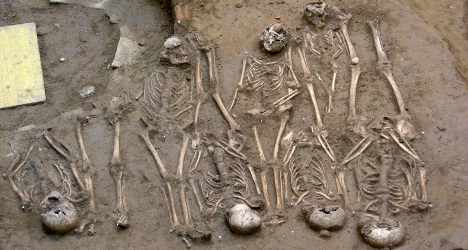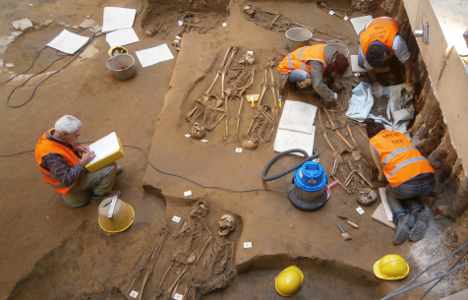'Plague' victims burial site found in Florence

Archaeologists in Florence have unearthed a burial ground by the city’s famed Uffizi Gallery, heralded as "an exceptional piece of documentary evidence" which will open a window onto life in Tuscany hundreds of years ago.
Around sixty skeletons have so far been discovered at the “vast cemetery”, thought to be the burial ground for victims of a plague which struck in the fifth or sixth century AD, Italy’s culture ministry (MiBAC) said in a statement.
The discovery offers “a snapshot of a catastrophe of huge proportions that struck Florence in the Early Middle Ages,” the ministry said.
Experts have concluded that the Florentines were struck by cholera, dysentery or an outbreak of flu, due to the way the skeletons were found, and buried by what is now the reading room of the Uffizi.
The bodies were squeezed in next to each other, head to feet, in a bid to make maximum use of the space available. Children’s skeletons were found “wedged into the narrow spaces between the adults,” the ministry said, pointing to hasty burials during a plague.

Scientists will be able to determine the Florentine diet from the skeletons. Photo: MiBAC
The team excluded the possibility that the Florentines could have been massacred in one of the numerous barbarian attacks on the city, due to the lack of injuries found and the way they were buried. They have also ruled out that the locals could have starved while the city was under siege, or died gradually from illness.
The find is of “extreme scientific importance” due to the broad cross-section of the population discovered, which will help scientists discover more about Florentines’ way of life hundreds of years ago.
A team from Johannes Gutenberg University of Mainz in Germany is investigating the cause of the epidemic, which is thought to have contributed to a long period of decline in Florence before it was transformed during the Renaissance into a hub of wealth of culture.
As centuries passed the cemetery was forgotten and the site, next to the Arno River, gave way to urbanization in the 12th and 13th centuries. The Uffizi Gallery was built in 1581 and has become a draw for tourists from across the world, attracting over a million visitors a year.
Don't miss a story about Italy - Join us on Facebook and Twitter.
Comments
See Also
Around sixty skeletons have so far been discovered at the “vast cemetery”, thought to be the burial ground for victims of a plague which struck in the fifth or sixth century AD, Italy’s culture ministry (MiBAC) said in a statement.
The discovery offers “a snapshot of a catastrophe of huge proportions that struck Florence in the Early Middle Ages,” the ministry said.
Experts have concluded that the Florentines were struck by cholera, dysentery or an outbreak of flu, due to the way the skeletons were found, and buried by what is now the reading room of the Uffizi.
The bodies were squeezed in next to each other, head to feet, in a bid to make maximum use of the space available. Children’s skeletons were found “wedged into the narrow spaces between the adults,” the ministry said, pointing to hasty burials during a plague.
Scientists will be able to determine the Florentine diet from the skeletons. Photo: MiBAC
The team excluded the possibility that the Florentines could have been massacred in one of the numerous barbarian attacks on the city, due to the lack of injuries found and the way they were buried. They have also ruled out that the locals could have starved while the city was under siege, or died gradually from illness.
The find is of “extreme scientific importance” due to the broad cross-section of the population discovered, which will help scientists discover more about Florentines’ way of life hundreds of years ago.
A team from Johannes Gutenberg University of Mainz in Germany is investigating the cause of the epidemic, which is thought to have contributed to a long period of decline in Florence before it was transformed during the Renaissance into a hub of wealth of culture.
As centuries passed the cemetery was forgotten and the site, next to the Arno River, gave way to urbanization in the 12th and 13th centuries. The Uffizi Gallery was built in 1581 and has become a draw for tourists from across the world, attracting over a million visitors a year.
Don't miss a story about Italy - Join us on Facebook and Twitter.
Join the conversation in our comments section below. Share your own views and experience and if you have a question or suggestion for our journalists then email us at [email protected].
Please keep comments civil, constructive and on topic – and make sure to read our terms of use before getting involved.
Please log in here to leave a comment.